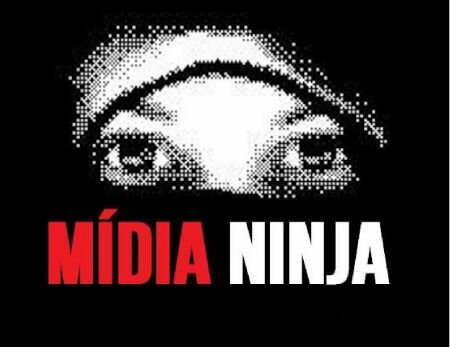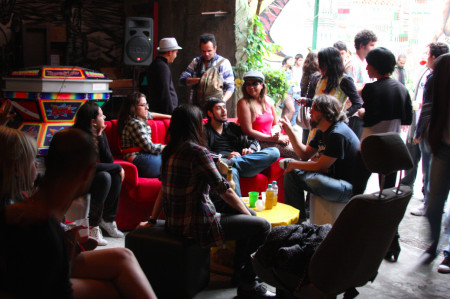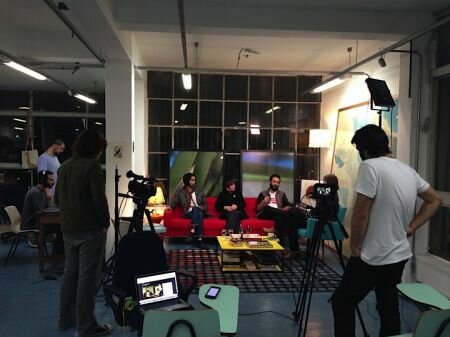Mídia Ninja
An activist journalism network specializing in real time broadcasting.
What is it?
NINJA Independent Narratives, Journalism and Action (aka Ninja Media) is a decentralized network of volunteer journalists who produce and disseminate content based on collaborative work and online sharing. Ninjas are primarily involved in real time broadcasting, but also produce news stories, documentaries and investigative journalism in Brazil and abroad.
“Our work is where the fight for social justice, and cultural, political, economic and environmental change takes place”
The collective became known internationally for its outstanding coverage of the 2013 Brazilian social protests but has existed since 2011. Its capillary organizational culture caters to the need for direct witnessing in an age of ubiquitous digital network communication.
Their statement on the Mídia Ninja website reads:

“The Internet changed journalism and we are part of this transformation. We live in a peer-to-peer culture that allows people to share information without traditional mediators. New technologies and new forms of using technology have opened the way for new sharing spaces, in which people do not only passively absorb information, but produce and exchange information. In this new context - of networks connected to streets - multimedia citizens emerge with the capacity to make and share opinions in the virtual world. Connected, these new narrators make NINJA Media.”

Mídia Ninja emerged within the Circuito Fora do Eixo ("Off Axis Circuit") a cultural cooperative founded in 2006 and devoted to fostering independent cultural production outside of mainstream broadcasting and radio systems in Brazil. Within Fora do Eixo a group of young journalists began to experiment with social media, blogs, and smartphones to report on the group's activities, including concerts. This was the birth of Mídia Ninja. Its operational logic was based on using the web and spontaneous mobilization to create a network of independent, non-monetized production and diffusion practices.

Once a minimalist infrastructure for media production was established, the group confirmed its commitment to an agenda of social and civil rights reporting, but gradually expanded its scope by experimentally developing new forms of direct reporting not linked to Fora do Eixo events.
Mídia Ninja’s first work with a wider impact was the extensive coverage of the Marcha da Maconha (Marijuana March, May 21, 2011, Sao Paulo), a public pro-Cannabis and free speech demonstration, which was violently repressed by the police.

The social rights demonstrations in 2013 found Mídia Ninja in its most productive moment, as the group had already matured into a network of young and courageous journalists, deeply familiar with multimedia technologies and fast digital filmmaking. When the riots began - and police violence increased - Mídia Ninja became one of the most prolific and widely cited media groups, directly witnessing and distributing video images of violence between policemen and demonstrators.

The Ninjas also provided protester testimonies, reacting to the reportages and editorials produced by Brazilian mainstream media. The group clearly put itself in a non-neutral position of narrative and storytelling contestation, trying to confront some of the repetitive, negative frames of the demonstrations and their participants in mainstream media.
During the protests, the Mídia Ninja network was recognized - both nationally and internationally - for transforming demonstrators into storytellers and valuable sources, in stark contrast with the absence of agility demonstrated by established media giants, whose ability to cover the widespread popular fury was hampered by budget cuts, lack of multimedia expertise, lay offs, and a general lack of creativity.
Since then, however, some criticism has emerged regarding Mídia Ninja's practices, focusing mostly on its networked organizational model and "no-cut" broadcasting philosophy. The climax of this criticism was a confrontation between traditional media professionals and Mídia Ninja’s Bruno Torturra and Pablo Capilé during TV Cultura’s Roda Viva, Brazil’s most important public TV talk show.
The program’s habitual stage set resembled a kind of trial courtroom, as the two young men displayed unusual restraint while being bombarded with questions about their political bias, and the sources of Mídia Ninja’s funding by a league of older men in suits about twice their age.
How does it work?
During the riots, the original group of ten Ninjas coming out of Fora do Eixo rapidly jumped to more than hundred. The majority were students, aged 18 to 24, with previous experience in social activism. For permanent video reporting on the protests, they used smartphones, small video cameras, light laptops and 3G Internet.

The unpaid, networked coverage of the riots simply emerged as a spontaneous, collaborative reporting act, facilitated and centralized by the Mídia Ninja creators, who had previously built the production infrastructure and communication network, including a web TV channel, significantly called Pós-TV (After TV).
Mídia Ninja co-founder Bruno Torturra has always insisted on his vision of journalism as a civic tool, in direct contact with reality, and on a radical philosophy that abjures editing. Sometimes, Mídia Ninja’s broadcasting simply consisted of a three or four hour-long take of one reporter showing images and talking with people.
Mídia Ninja is based on the advantages of the digital capture and editing revolution of the past decade, allowing the radicalization of corpo- a-corpo approach and techniques inspired by war journalism and reporting. The idea behind its non-stop shooting is a direct sharing of experiences, e.g. when arrested at a Rio de Janeiro demonstration, one Ninja kept transmitting from inside the police car on his way to the local police station.
After the riots, Mídia Ninja gained international notoriety and went through a process of rethinking, with the intention of rewriting the rules of the collective and finding new ways to financial sustainability, professionalization, and long term independence.
Why did we select it?
The agility of Mídia Ninja’s networked organizational form takes full advantage of the digital revolution to provide better journalism. It allows journalists "to be there at the right moment", without a big, expensive infrastructure. They reinforce independent journalism by challenging the news monopoly of traditional media corporations. With its coverage of the 2013 riots, it illustrated a power shift taking shape on the ground.
Furthermore, Mídia Ninja has radically de-monetized news production and consumption and reframed journalism as a public good. Lastly, they revitalized the use of non-edited and live video reports, raising public debate about the definition of journalism in the 21st century.
While Ninja’s critics have argued that good journalism always involves conscious and careful selection of relevant facts and analysis, Ninjas have emphasized that the decision to be at a certain place at a certain time, or to point the camera in a certain direction, are also editorial decisions. Mídia Ninja’s riot coverage reminds us that new situations require new approaches and a continuous negotiation of arrangements.
Oximity and Fluxo
Mídia Ninja is working closely with Oximity, a hugely successful and well-funded platform for citizen journalism in Brazil. Recently, Mídia Ninja’s founder Bruno Torturra started a new journalism collective in Sao Paulo, called Fluxo.

Bruno Torturra: “Fluxo is a newsroom, a live-streaming studio, a space for meetings and gatherings in the centre of São Paulo. It’s where reporters, photographers, film-makers, editors and artists are coming together to explore new journalistic possibilities, both in terms of content and in the relationship between communicators and public."
Become a Ninja yourself!
"Any person can join Mídia Ninja's nonprofit, open network based on collaborative work. You can generate and replicate content from any place in the world, participate in LAB NINJA workshops in your city, translate content or make a donation to help fund their work."